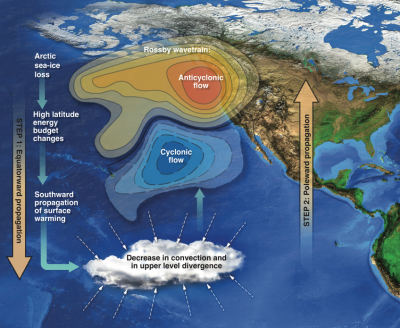Future Loss of Arctic Sea-Ice Cover Could Drive a Substantial Decrease in California’s Rainfall
By sampling the uncertainties in selected sea-ice physics parameters, Lawrence Livermore National Laboratory scientists in the Atmospheric, Earth and Energy Division developed a novel method for isolating the impacts of high latitude sea-ice loss. Their research shows that Arctic sea-ice loss of the magnitude expected in the next few decades could substantially impact California’s rainfall thus exacerbating future California droughts.
Previous studies have suggested that California’s drought has a manmade component arising from increased temperatures, with the likelihood of such warming-enhanced droughts expected to increase in the future. This study highlights yet another pathway by which human activities could affect the occurrence of future droughts over California - through human-induced Arctic sea-ice loss. The study also suggests that the ability of climate models to accurately estimate future precipitation changes over California may be linked to the fidelity with which future sea-ice changes are simulated.
The dramatic Arctic sea-ice loss observed over the satellite era has intensified debate into whether these high latitude changes are affecting weather and climate outside of the Arctic. Many previous attempts to demonstrate statistically significant remote responses to sea-ice changes have been hindered by factors such as large high latitude variability and short observational datasets. In this study, a new modeling framework, involving sea-ice physics parameter perturbations, was developed in order to isolate the climate response arising from changes in Arctic sea-ice cover alone.
Performed simulations indicate that the loss of Arctic sea-ice cover drives the formation of a high-pressure ridge in the North Pacific - much like the ridges that have been pushing the winter storm systems away from California during the 2012-2016 drought. In a two-step teleconnection, sea-ice changes lead to reorganization of tropical convection that in turn triggers an anticyclonic response over the North Pacific, resulting in significant drying over California. The mechanism behind this teleconnection appears to be robust to the source of high-latitude sea ice changes: it is shown that Antarctic sea ice loss can also trigger substantial precipitation changes over California.
This research indicates that substantial loss of high-latitude sea-ice cover is highly likely to have significant far-field effects, and can impact California’s precipitation through atmospheric teleconnections involving tropical convection changes.

